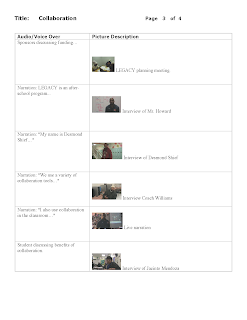Equipped with digital tools today's learning environments can enhance learning. A learning environment must be supportive, open, and respectful (Durrington, Berryhill, & Swafford, 2006). Therefore, it is important to use everyday technologies to engage learners. The three areas of focus that could help facilitate this integration are content, communication, and collaboration. Appropriate content allow learners to share ideas. In order to generate content knowledge learners can use a) file sharing, b) webinars, c) e-books, d) websites, and e) DVDs. These tools allow learners to develop their content knowledge, in order to have a knowledge base for communicating with peers.
When learners exchange ideas, interest, and goals they are experiencing the openness needed for an active and engaging learning environment. When a learner feels supported and they are open to sharing communication is effective. According to Durrington, Beryhill, and Swafford (2006) discussion boards are effective for learner-to-learner interactions. Discussion boards provide a space for learners to communicate while developing critical thinking and other cognitive skills. Embedded in our everyday lives cell phones provide convenient access for communicating. Learners can use cell phones to email, text, instant message, and check Facebook. Vesisenaho et al. (2010) advances the notion that mobile technologies and social software enhances the design of teaching and learning. By using cell phones to engage learners, educators are building pathways for live long learners.
Collaboration is sharing and creating with others. On of the most effective ways, to engage learners in collaboration is problem-based learning. Problem-based learning focuses on student-centered activities that relate to real world problems (Durrington, Berryhill, & Swafford, 2006). This approach allows learners to identify common interest, develop common goals, and share knowledge. Some everyday technologies that foster collaboration include wikis, chat rooms, blogs, shared whiteboards, and videoconferencing. These tools give learners a verity of mediums for interaction; however, the driving force behind their effectiveness is the learners ability and willingness to employ them in learning environments.
References:
Durrington, V., Berryhill, A., A& Swafford, J. (2006). Strategies for enhancing student interactivity in an online environment. College Teaching, 54(1), pp. 190-193.
Vesisenaho, M., Valtonen, T., Kukkonen, J., Havu-Nuutinen, S., Hartikainen, A., & Katkkainen, S. (2010). Blended learning with everyday echnologies to activate students' collaborative learning. Science Education International, 21(4), pp. 272-283. Retrieved from http://www.icaseonline.net/sei/december2010/p4.pdf





